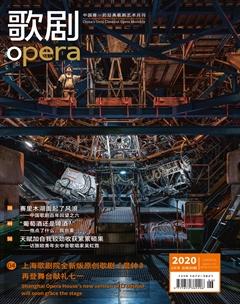“葡萄酒還是啤酒?”
司馬勤
這段日子,我心里一直想著要喝酒。這是長期待在家中自我隔離的附屬癥狀。還有一種可能是,就算世界各大歌劇院還沒有因為疫情關門之前,這些年來家里的酒吧推車(bar cart)一直停在那個從地面到頂棚都擺滿歌劇錄音的架子旁。你也許會把這種念頭歸咎于社會心理學的接近原則(proximity principle),但我開始考慮認真地探討下美酒與歌劇這兩者之間的關系。
前兩個月,我在專欄里曾半開玩笑地說過,當歌劇院重開大門舉行演出,如果從指揮的第一拍起拍直至終場落幕之間,觀眾隨時可以品嘗美酒,那該多好。當然,我不是慫恿歌劇迷變酒鬼。我只是希望觀眾把目光聚焦于舞臺上演員所喝的酒類。他們怎樣喝酒、在哪里喝酒,尤其是在臺上喝哪種酒,都可以讓我們更透徹地了解歌劇中的人物與劇情,遠比文字更為深刻。你只要隨便翻開歐內斯特·海明威(Ernest Hemingway)或斯科特·菲茨杰拉德(Scott Fitzgerald)的著作——或者伊夫林·沃(Evelyn Waugh)、又或金斯利·艾米斯(Kingsley Amis)(我還可以列出更多更多的名字……)——你就會明白我的意思。
其實,這一目標也不必定得太高。就拿通俗小說(genre fiction)中的幾位人物為例:伊恩·弗萊明(Ian Fleming)筆下的英國間諜“007”詹姆斯·邦德(James Bond),與雷蒙·錢德勒(Raymond Chandler)系列小說中的美國私家偵探菲利普·馬洛(Philip Marlowe)。就算你熟知這些人物最鐘愛的雞尾酒,我也不會給你加分:馬洛讓琴蕾酒(gimlet,又名螺絲起子)發揚光大(“一半琴酒,一半玫瑰牌青檸檬汁,不加其他”);邦德令馬丁尼(martini)風靡一時(“伏特加……搖勻,不要攪拌”)。盡管今天的調酒師對于以上兩個傳統的配方都不以為然,但是這兩種雞尾酒卻多多少少顯露了顧客的心境或背景。
錢德勒描述的這款雞尾酒像是為12歲孩子口味而設,而不是為了成人顧客。馬洛當年的琴酒可能比不上今天蒸餾三次之后的高質量品種吧。邦德較喜歡“搖勻,不要攪拌”的調酒方法,讓冰塊會融化得更快,所以他的馬丁尼比常見的要冰得多,酒精度也稀釋不少(因此他執行任務時也不會醉醺醺)。選擇伏特加卻令人費解……也許連他也找不到好品質的烈酒。我腦海里更浮現這個疑問:為什么冷戰時期英國政府鼎鼎大名的“鐵金剛”會喜歡敵國最標志性的烈酒,而不選英國引以為傲的琴酒呢?邦德真是一個充滿神秘的人物。
對不起,我又偏題了。在歌劇范疇里,雞尾酒——或者任何烈酒——出現的機會比較罕見。歌劇藝術大多追溯至意大利與德國的文化根源,所以常見的酒類是葡萄酒與啤酒。但是,即便在這些范圍內,可能參考的不同案例也很廣泛。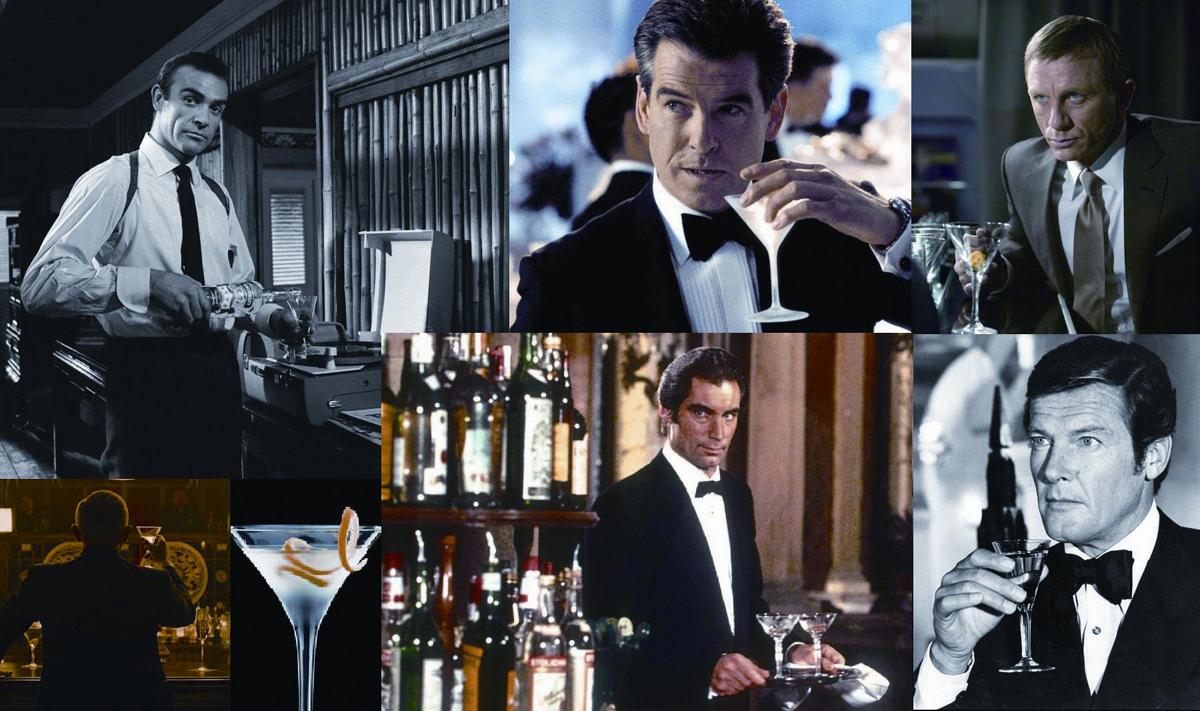
我們也有很多方法,把“賞酒”與“ 賞歌劇”結合起來。我可以聯想到朋友在家中一邊看歌劇視頻,一邊有創意地創造出嶄新的行酒規則:每當劇中人提到喝酒,觀看者也需呷上一口;如果歌劇的某場景發生在酒館內,就要大口喝;涉及喝酒的詠嘆調或合唱曲一出現,大家就要一起干上一杯。那些志同道合、擁護“褲子喝醉了”(kalsarik?nnit,還記得我曾提到的那個待在家里、只穿內褲、喝得爛醉的芬蘭傳統)的朋友或已定出了一套獨家“賞酒賞歌劇”的規則了。
今天,正因我坐在家中的歌劇唱片架子與酒吧車之間,讓我們一起參考“賞酒賞歌劇”的幾個亮點,看看不同角色的杯中物帶給我們什么深入見解。
“哎,酒保!”——威爾第《法爾斯塔夫》(1893)
莎士比亞筆下的約翰·法爾斯塔夫爵士是舞臺上首屈一指的品酒權威。這位出身貴族但品行卑劣的武士畢生追尋多種不良嗜好、揮霍無度。這威爾第最后一部的歌劇一開幕,法爾斯塔夫就已經在喝酒。到了第三幕,約翰爵士第一句就埋怨“這個坑蒙拐騙的世界”;到了詠嘆調的尾聲,他的心情明顯好得多,因為有酒下肚了,“心臟里每一細胞都震動,顫音般的瘋狂震撼著歡樂的地球”。就在這一刻,你真想跟酒保說:“他點了什么,我也要。”可想要研究他當時喝了什么這個細節就復雜了,我們要回溯莎士比亞的文本。在《溫莎的風流娘兒們》(The Merry Wives of Windsor)中,法爾斯塔夫提及過加了丁香與草藥的蜂蜜酒(metheglin)。但是,他平常喝的薩克酒(sack),是干雪利酒(dry sherry)的前身,酒精度高于葡萄酒,質感與口感跟中國黃酒差不多(法爾斯塔夫更吩咐酒保要把酒加熱)。我要鄭重聲明,法爾斯塔夫沒有喝過啤酒,即便現在起碼有五個美國啤酒廠的產品用上了法爾斯塔夫的肖像或名字作為宣傳伎倆。
“葡萄酒還是啤酒?”——古諾《浮士德》(1859)
這個重要議題出現在《浮士德》第二幕的開端。一群學生、士兵與居民興高采烈,異口同聲地唱“酒鬼什么都喝”。(很有趣,1979年百代唱片錄音的德語劇本翻譯,卻把歌詞譯為“葡萄酒與啤酒”,連問號都刪掉。)以我剛剛提出的喝酒游戲規則來說,這一段的勝利之聲壓倒全場。以喝酒為主題的大合唱重復了幾遍,酒館這個公眾聚集的地方也推動戲劇發展。從歷史角度來看,酒館是平常互不相干的社會群體的共用空間,在故事里營造出享樂與冒險這兩條線索。士兵準備上戰場,瑪格麗特(Marguerite)首次亮相,而梅菲斯特(Méphistophélès)刻意種下禍根,把自己酒窖的酒釀拿出來,令眾人喝個大醉。到了最后,美酒爆出火焰,令我懷疑魔鬼收藏的釀酒質量是高是低。
“一只老鼠在廚房”——柏遼茲《浮士德的懲罰》(1846)
又是一位法國作曲家,把歌德最富德國色彩的文本編成歌劇。《浮士德的懲罰》在巴黎喜歌劇院首演后的多年里長期被忽略,到了最近才成為保留劇目,主要歸功于現代舞臺技術(尤其是高像素投影)凸顯了歌劇的奇幻效果。柏遼茲與古諾節錄的故事情節有不少重疊——在酒館那一場,更安排了一個醉醺醺的學生領唱,描述老鼠在廚房尋歡作樂,最后吃錯毒藥而死的詠嘆調——這段是一個巧妙的源自歌德原著的戲劇工具。在古老的民間傳說里,浮士德在烏煙瘴氣的酒館里開啟他淪落之途——說真的,除了酒館,還能在哪里遇得上魔鬼?——歌德的原著中的酒館,是萊比錫名副其實的地標(1498年已經開業的奧爾巴赫酒窖,Auerbachs Cellar)。歌德特意增添這點喜劇性,讓本來污穢的酒館變得更有生氣。他的處理手法也影響了后世浮士德故事的定調。
“讓我們高舉起歡樂的酒杯”——威爾第《茶花女》(1853)
毫無疑問,這是歌劇世界里的頭號祝酒歌,捕捉到常住巴黎最有名的交際花與她那布爾喬亞敬慕者初相識的浪漫時刻。我們大多數人都稱這首歌為“祝酒歌”(Brindisi,意大利語“祝酒歌”,源自德語祝酒詞“我獻給你”[ich] bringe dirs)。當薇奧萊塔跟客人寒暄過后走開幾步,阿爾弗萊多帶領各位賓客高歌一曲,祝酒詞就是“讓我們高舉起歡樂的酒杯”,從而吸引到薇奧萊塔那“無法抗拒的目光”。茶花女漠視阿爾弗萊多的奉承,鼓勵賓客們“享受生命,因為愛的歡樂短暫易逝”。到頭來,薇奧萊塔被迷住,可惜她跟阿爾弗萊多的愛情確實短暫易逝。雖然歌詞字面包含言外之意,但威爾第如泡騰片般的音樂讓我可以肯定,沙龍的客人的酒杯里盛載著香檳。
“干了這杯氣泡酒”——馬斯卡尼《鄉村騎士》(1889)
很明顯,我們都知道馬斯卡尼歌劇里的村民在喝什么,因為“氣泡酒”出現在曲目題目中。但我們要弄清楚:威爾第創作了眾所周知的“祝酒歌”;馬斯卡尼只寫出了“一首祝酒歌”,但這位年輕作曲家畢生第一部獨幕歌劇卻把現實主義推進舞臺。很多樂評人都察覺到歌劇敘事手法的變化——我最喜歡的描述是這樣:現實主義把上等人家族里的奸淫、誘惑、殺戮與自殺轉移至普通人生活中發生的奸淫、誘惑、殺戮與自殺——你也聽得出祝酒歌風格上的差別。參軍回來的圖里杜(Torridu)適逢復活節,跟村民一起干杯。圖里杜情人的丈夫到來,拒絕與他共飲,兩人相約決斗。最后悲劇收場。
“我們來個豪華晚宴,要他們醉醺醺”——莫扎特《唐喬瓦尼》(1787)
編劇達·蓬特的劇本從沒有指定唐喬瓦尼最沉醉什么,但導演彼得·瑟勒斯(Peter Sellars)曾要求男主角在臺上演繹自己打了毒品針——但是大家都明白,自然界里是沒有真空的。唐喬瓦尼在第二幕唱出頌贊美酒、女人與歌舞的詠嘆調,一早就被稱為“香檳詠嘆調”,莫扎特的音樂就像冒著氣泡的美酒,更帶有一點輕佻。整首詠嘆調只有90秒時長,但角色的本質性格卻表露無遺,絕對是歌劇歷史的里程碑。
“酒神萬歲”——莫扎特《后宮誘逃》(1782)
從放蕩不羈的唐喬瓦尼到滴酒不沾的奧斯明(Osmin),莫扎特筆下的人物涵蓋兩極。嚴格上來說,《后宮誘逃》是莫扎特首部獲皇室委約的舞臺作品(包含對白,德語演出),利用純音樂呈現劇情的段落不算多,但作曲家仍成功地挑戰了當年常規的極限——最顯著的一點是,他把土耳其風格的一切都借了過來。為了從土耳其國王帕夏(Pasha)的總管奧斯明手上救回未婚妻布隆德(Blonde),佩德里洛(Padrillo)擬出計劃,慢慢灌醉奧斯明——雖然這位總管是個回教徒。奧斯明破壞了真主的戒條,甚至贊嘆“酒神是個好家伙”,險些改變信仰追隨羅馬酒神,但終于醉倒昏迷。這是一首旖旎的歌曲,別忘了作曲家是如假包換的異教徒。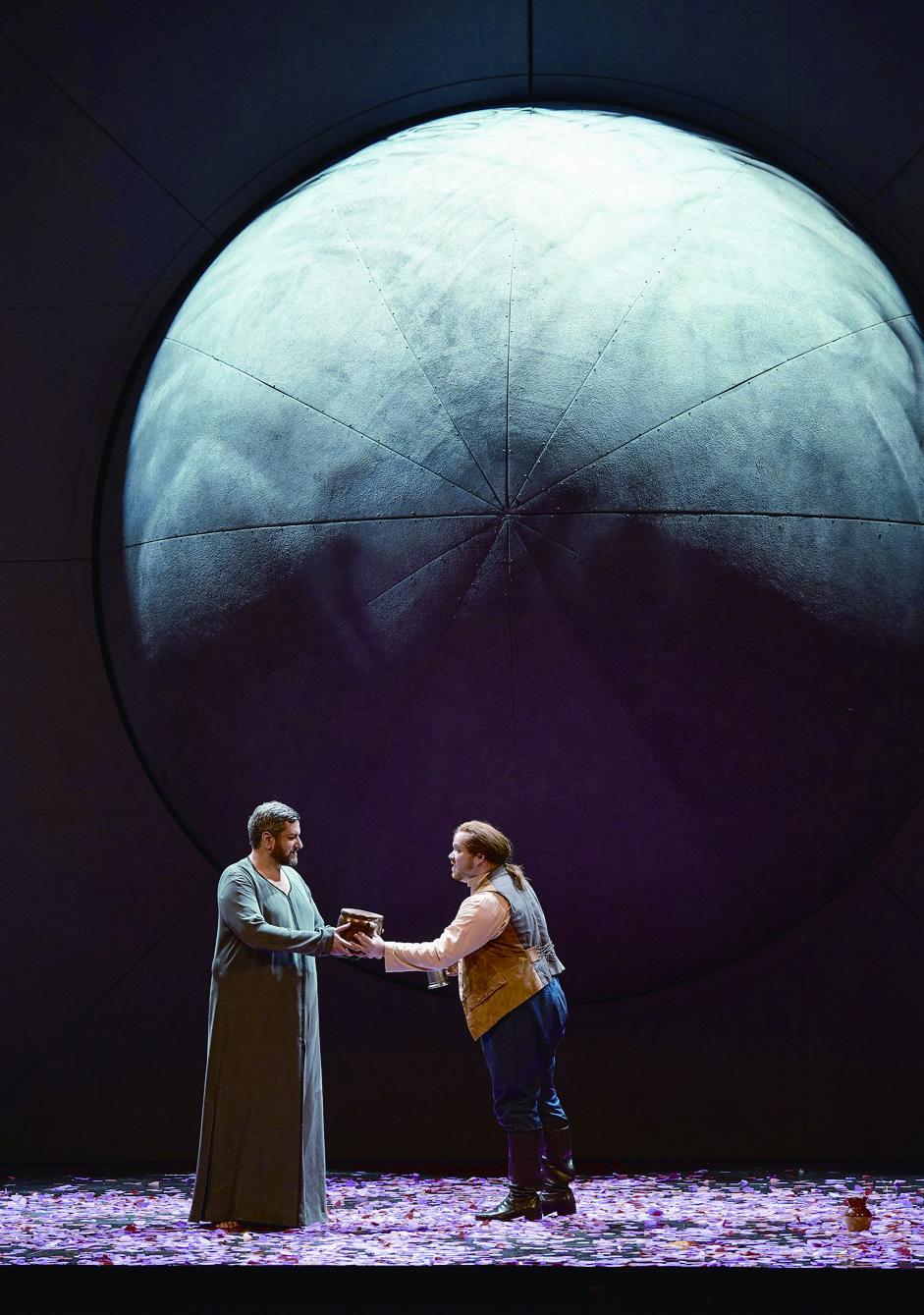
“快點,快點,快點,路德老板”——奧芬巴赫《霍夫曼的故事》(1881)
很多人都抱著懷疑,恩斯特·特奧多爾·威廉·霍夫曼(E.T.A. Hoffmann)是一位酗酒的作家,還是舞文弄墨的酒徒。奧芬巴赫的首部(也是唯一一部)歌劇兩者兼并,一開幕就帶我們到訪路德酒館。在那里,烈酒與葡萄酒的靈魂都自薦是作家的繆斯(這當然是被潤飾的浪漫化版本,霍夫曼只活到46歲,元兇就是他的那些“繆斯”)。確實,過了幾分鐘,當合唱團介入的時候,酒精飲品很明顯為故事情節添上動力。剩下來的問題很簡單:葡萄酒還是啤酒?作曲家故意不加選擇——只激勵大家“把酒杯盛滿,直到天亮”——做法恰當,因為作曲家在德國出生時的名字是雅各布·埃伯斯特(Jakob Eberscht),移居法國后,展開音樂生涯所用的名字是雅克·奧芬巴赫。
“喝!喝!喝!”——龍伯格《學生王子》(1924)
雖然奧芬巴赫在歌劇范疇的傳承不算很重要,但對于輕歌劇的發展——延伸至音樂劇——卻舉足輕重。要是我們比較一下奧芬巴赫與龍伯格的合唱曲,我們就看得出歌劇與輕歌劇風格上的很大區別。《霍夫曼》的合唱曲里,音樂幾乎沒有停頓,說明情節甚至推動故事;《學生王子》[桃樂絲·唐納利(Dorothy Donnelly)的劇本與歌詞]大致把德語話劇《老海德伯格》(Old Heidelberg)移植至美國舞臺,增添的歌曲對于故事發展沒有很大的影響。盡管這樣說,《學生王子》依舊是20世紀20年代百老匯最長壽的劇目,吸引觀眾的歌曲非“喝!喝!喝!”莫屬——為什么會出現這個狀況?因為該劇上演時,正是美國的禁酒令年代,無論釀酒或賣酒都違法。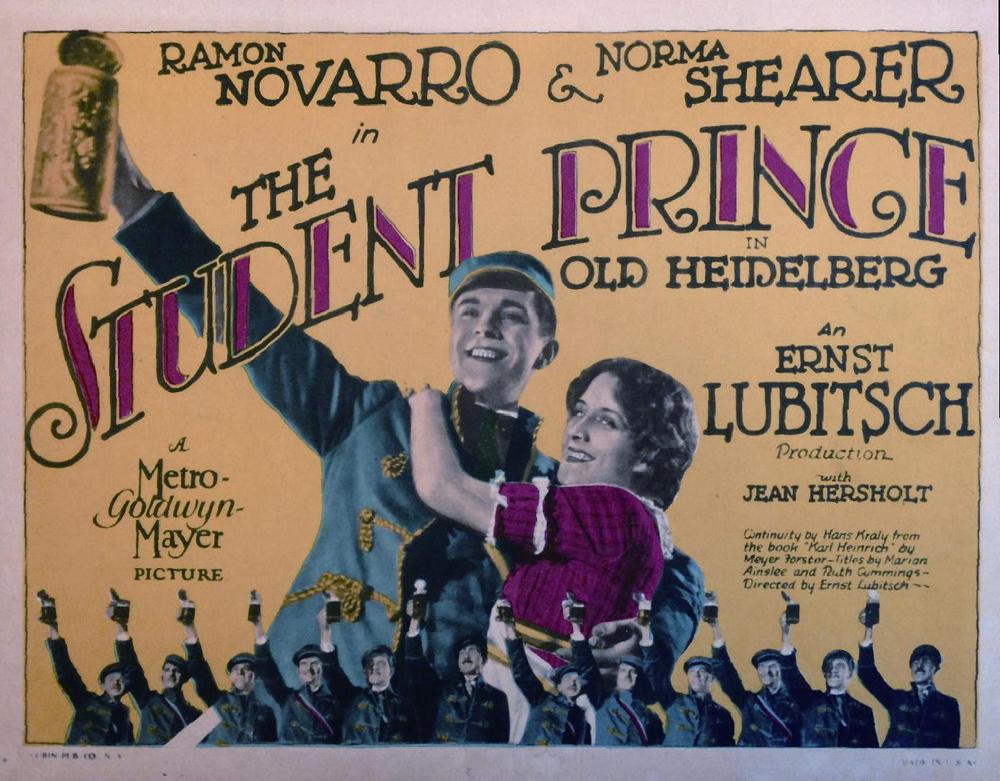
“啤酒是天賜的禮物”——斯美塔那《被出賣的新娘》(1866)
大多數歌劇都偏袒葡萄酒——雖然奧芬巴赫與龍伯格的舞臺制作里都找得到啤酒,那些歌劇還是比較中立。我終于找來一位立場清晰的作曲家。斯美塔那的父親是釀啤酒的商人,在《被出賣的新娘》第二幕的開場,村民齊聲高歌地唱道:“啤酒是天賜的禮物”。雖然這部歌劇的首演并不成功——第一版包含很多對白,觀眾反應冷淡——斯美塔那修改后的版本把對白刪掉,音樂配合捷克語調的自然節奏與脈搏一氣呵成。當劇中人爭執究竟愛情還是金錢要比啤酒更重要,村民完全不理他們,繼續暢飲啤酒——印證了這個以啤酒為傲的文化的真實性。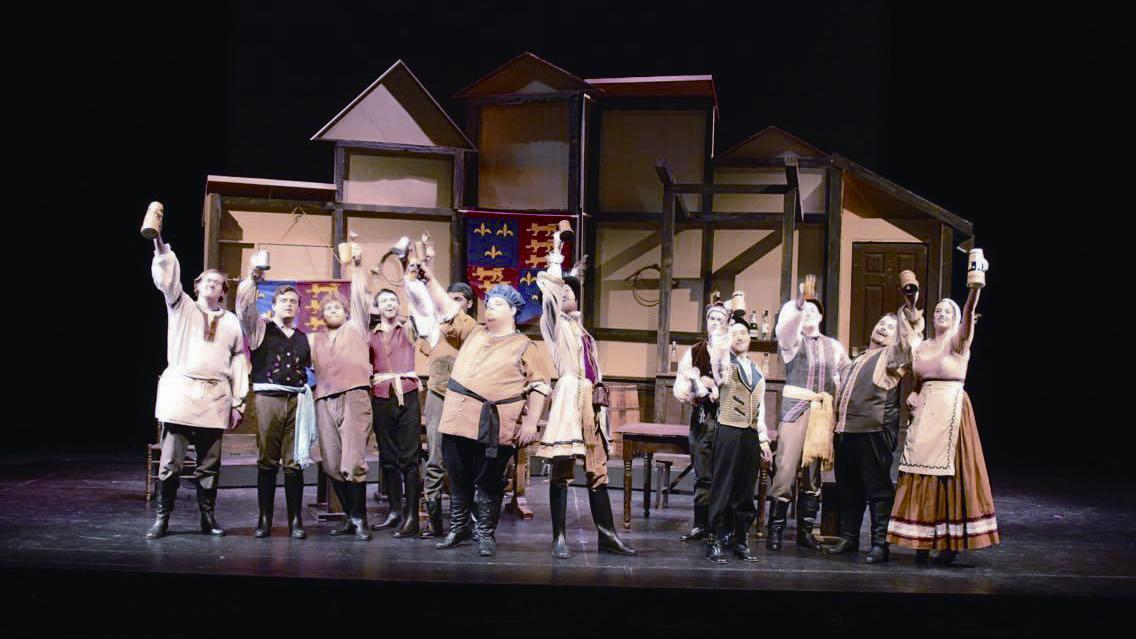
Ive been thinking a lot about drinking lately. Being quarantined does that. It probably doesnt help that, even before opera houses around the world closed their doors, my bar cart was sitting beside a floor-to-ceiling shelf of opera recordings. Blame it on the proximity principle, but Ive started pondering relationships between the two.
This is not to endorse the idea—hinted halfseriously a couple of months ago—that once opera houses open again that alcohol should be available from downbeat to curtain call. Rather, its time for audiences to pay more attention to what the characters on stage are quaffing. How, where and especially what someone is drinking often reveals more than words alone can describe. Just page through any book by Ernest Hemingway or Scott Fitzgerald—or Evelyn Waugh or Kingsley Amis (I could go on…)—and youll see what I mean.
You dont even have to aim that high. Start with a couple of characters from middlebrow genre fiction—say, Ian Flemings British spy James Bond and Raymond Chandlers American private detective Philip Marlowe. No bonus points for naming their respective drinks: Marlowe did for the gimlet (“half gin and half Roses Lime Juice and nothing else”) what Bond did for the martini (“vodka…shaken, not stirred”). Neither recipe would pass the scrutiny of a grown-up bartender, but they do reveal a lot about the customer.
Chandlers overly sweet proportions show that perhaps Marlowes gin was not of triple-distilled quality. Bonds preference for “shaken, not stirred”meant that his ice melted faster, so his drinks were(1) much colder and (2) more diluted than usual (also making him less drunk on the job than he might appear). As for the vodka…maybe that wasnt such high quality, either. And what does it say when, during the Cold War, a government agent from a nation of gin drinkers prefers the primary export of his chief rival? Bond was certainly a man of mystery.
But I digress. Getting back to opera, references to cocktails—or liquor in any form, for that matter—are few and far between. Since the art forms two most prominent roots are in Italy and Germany, wine and beer are the usual tipples. But even within those perimeters, the range of references is quite broad.
So, too, are the ways to build these into our operatic appreciation. I can already imagine home viewing parties morphing into elaborate drinking games: a sip for every time someone casually mentions some form of alcohol, a long gulp for any scene set in a drinking establishment, an entire glass during any aria or chorus predominantly featuring a fermented beverage. Some devotees of kalsarik?nnit (or “pantsdrunk,” that Finnish tradition I cited a couple of months ago about people drinking at home wearing only their underwear) are probably doing that already.
But for the time being, since Im already sitting about halfway between the bottles and the opera recordings, lets take a deeper look at the genre and see what insights we can glean from our characters choice of beverage.
“Ehi, Taverniere!”
from Verdis Falstaff (1893)
The stage has no greater authority on drinking than Sir John Falstaff, Shakespeares high-born lowlife who squanders his knighthood on a variety of disreputable pastimes. Verdis final opera opens with Falstaff already drinking; by Act III, Sir John starts out raving about “a thieving, wicked world,” then once the wine kicks in, “every fiber in the heart vibrates, and a trilling madness rocks the joyous globe.” This is when you tell the taverner, “Ill have what hes having.” For details, though, we need to go back to Shakespeare. In The Merry Wives of Windsor Falstaff mentions metheglin, a honey wine spiced with cloves and herbs, but his most reliable drink is sack, an early form of sherry stronger than regular wine and rather similar in consistency and flavor to huangjiu (which Falstaff even asks to be warmed). For the record, he never drank beer, despite at least five American breweries using Falstaffs image or name to promote their products.
“Wine or Beer?” from Gounods Faust (1859)
The relevant question opens Act II, with a chorus of students, soldiers and locals all cheerfully agreeing that “a drunkard drinks everything.”(Tellingly, my German translation is “Wine and beer,” with no question mark.) By the standards of our drinking game, this is a clean sweep, not merely set in a tavern with a recurring drinking chorus but having substantial plot developments unfold within the very definition of a “public house,” where otherwise incompatible groups find themselves sharing the same space. Soldiers are about to head off to war, Marguerite makes her first appearance, and Méphistophélès sows seeds of discontent in all quarters, partly by plying the crowd with wine from his own cellar. The fact that the liquid bursts into flames, though, shouldve made people question the vintage.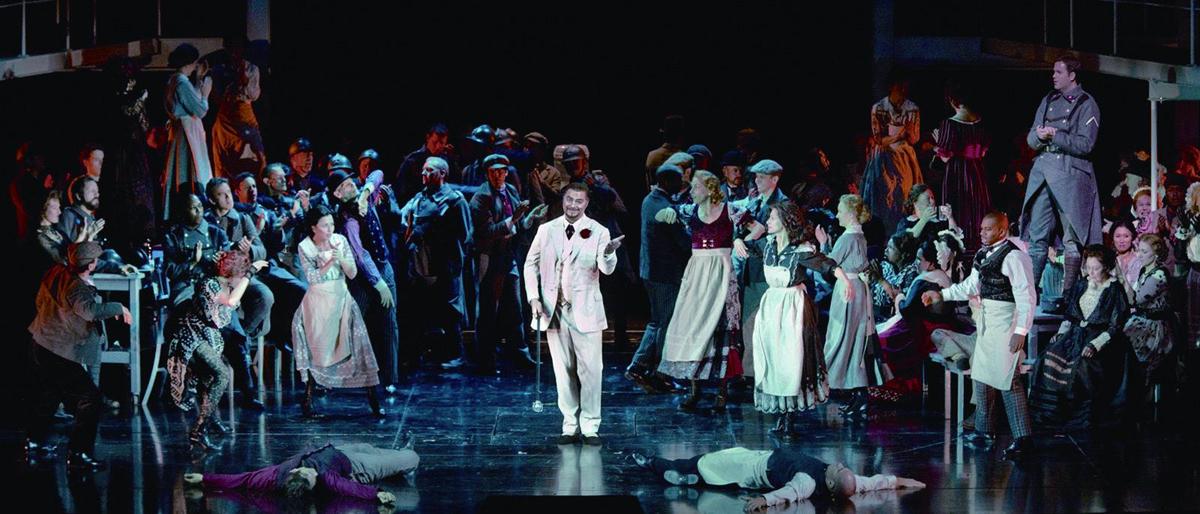
“Certain rat, dans la cuisine”
from Berliozs Damnation of Faust (1846)
Berliozs equally French take on Goethes truly German drama premiered at Pariss Opéra-Comique but only secured a place in the opera house once modern stagecraft (particularly video projections) could illuminate the storys mystical effects. Some of the overlap with Gounods version—including the tavern scene, complete with a drunken student singing about a rats revels in the kitchen ending after eating a batch of poison—stems from essential dramatic devices in Goethes telling. Though the folkloric Fausts downward spiral had long been portrayed in a seedy tavern—really, where else would you meet the Devil?—Goethe had set the scene in Auerbachs Cellar, an actual tavern in Leipzig that had been in existence since 1498. By lightening the sordid setting for comic relief, Goethe set the tone for future adaptations.
“Libiamo nelieti calici”
from Verdis La Traviata (1853)
Without doubt the most famous drinking song in all of opera, the musical backdrop where Pariss resident party girl first meets her bourgeois admirer is known simply as The Brindisi (Italian for “drinking song,” but appropriately enough, derived from the German toast (ich) bringe dirs, or “(I) offer it to you”). Stepping away from the other guests in her salon, Alfredo leads his toast with “Drink from the joyful glass, resplendent with beauty,” drawing attention to Violettas “irresistible gaze.” Violetta brushes aside the flattery, urging all her other guests to “be joyful, for love is a fleeting short-lived joy.”Still, Violetta is hooked, and indeed her love with Alfredo is short-lived. Despite weaving its dramatic subtexts, the musics pure effervescence leaves little doubt that its champagne in the glasses.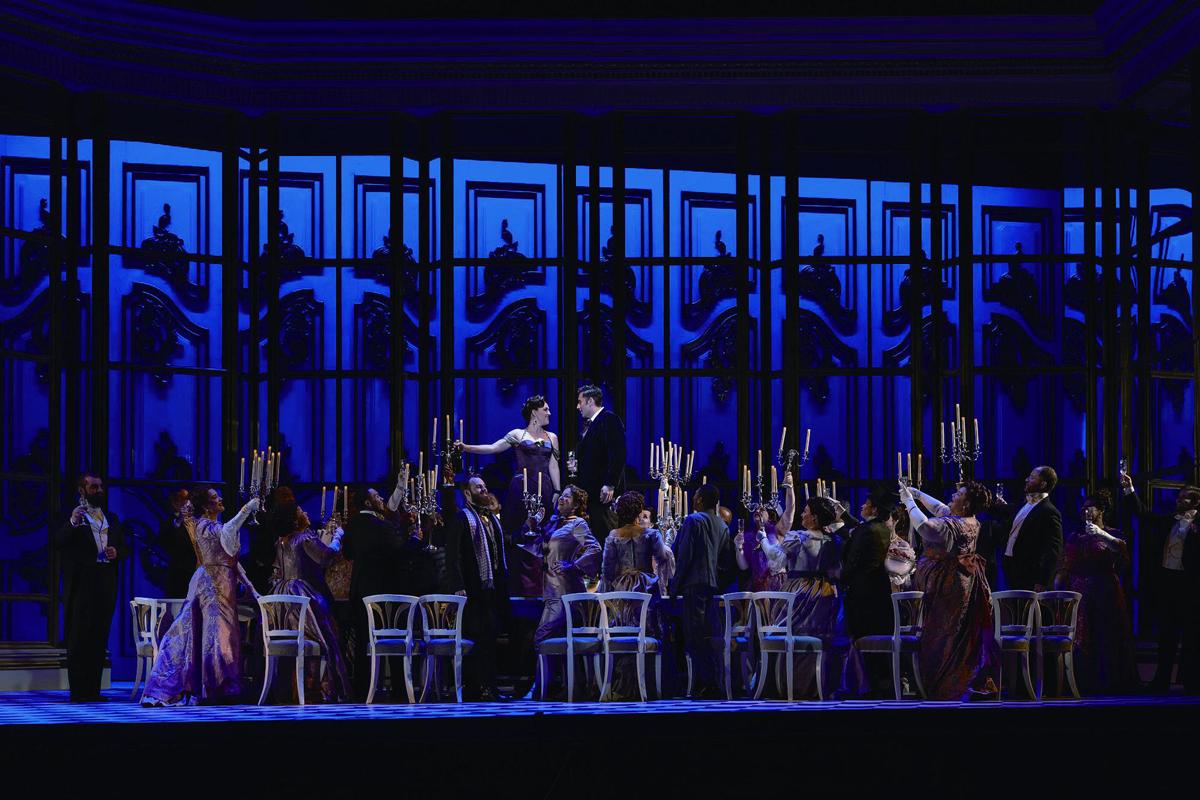
“Viva, il vino spumeggiante”
from Mascagnis Cavalleria Rusticana (1889)
Theres no doubt what Mascagnis peasants are drinking either, since the word “sparkling”is right there in the title. To be clear, Verdi wrote The Brindisi; Mascagni merely wrote “a brindisi,”but this one-act work—his first opera—essentially propelled verismo on the opera stage. Many critics have observed how this changed operatic storytelling—my favorite description is that verismo replaced adultery, seduction, murder and suicide in the highest families with adultery, seduction, murder and suicide in the lowest families—but a clear stylistic contrast is evident even in their drinking songs. As the returning soldier Toriddu leads his fellow villagers in an Easter Day toast, his girlfriends husband arrives, refuses Toriddus wine and challenges him to a duel. It doesnt end well.
“Finchhan dal vino”
from Mozarts Don Giovanni (1787)
Librettist Lorenzo Da Ponte never specifically mentions Giovannis intoxicant of choice—director Peter Sellars notoriously had the Don shooting heroin—but tradition, as they say, abhors a vacuum. Giovannis Act II paeon to wine, women and dancing has long been dubbed the “Champagne Aria,”with Mozarts music practically bubbling over with licentiousness. Running no more than 90 seconds, no aria in the history of opera has delved so aptly and efficiently into the nature of the character singing.
“Vivat Bacchus” from Mozarts
Abduction from the Seraglio (1782)
From the libertine Giovanni to the teetotal Osmin, Mozarts characters clearly run to extremes. Though the strict terms of Mozarts first imperial commission (a German-language stage work with spoken dialogue) left limited room to tell the story in purely musical term, the composer nonetheless managed to push contemporary conventions to their limits—not least the faddish appropriation of all things Turkish. Padrillos plans to free his fiancée Blonde from the clutches of Osmin, the Pashas overseer, involve incapacitating Osmin one glass at a time—despite the overseers Islamic beliefs. Allahs prohibitions soon give way, with Osmin declaring that “Bacchus is a fine fellow” and nearly shifting his allegiance to the Roman god of wine before passing out. A charming set piece, composed by a confirmed infidel.
“Drig, Drig, Drig, Ma?tre Luther”
from Offenbachs Les Contes dHoffmann (1881)
Some question still remains whether E.T.A. Hoffmann was primarily a writer who drank or a drinker who wrote. Offenbachs first (and only) true opera plays both sides, opening in Luthers Tavern with the spirits of wine and beer claiming to be the writers Muse (a romanticized version, to be sure, since Hoffmann himself died at 46, largely a victim of his “muse”). And indeed, when the chorus enters a few minutes later, it is the drinking that leads to the storytelling. The only remaining question is, well, wine or beer? Both are treated rather indiscriminately—the only exhortation being“Fill the cups till dawn”—with no obvious cultural allegience, truly befitting a composer who was born in Germany as “Jakob Eberscht” and made his musical career under the name “Jacques Offenbach”in France.
“Drink! Drink! Drink!”
from Rombergs The Student Prince (1924)
Though Offenbachs legacy in opera is negligible, his influence on operetta—and by extension, the future of musical theatre—was enormous. The difference between the two stage genres becomes apparent comparing the place of Offenbachs drinking chorus with that of Rombergs. In Hoffmann, the music runs almost continuously throughout, illustrating and often advancing the narrative; The Student Prince (with book and lyrics by Dorothy Donnelly) more or less adapted the German-language play Old Heidelberg to the American stage, its songs adding little to the story. That said, The Student Prince was the longestrunning show on Broadway in the 1920s, its popularity driven mostly on the basis of its “Drink, Drink! Drink!” chorus—a phenomenon partly explained by the fact that the United States was in the middle of Prohibition, when it was illegal to produce or sell alcohol.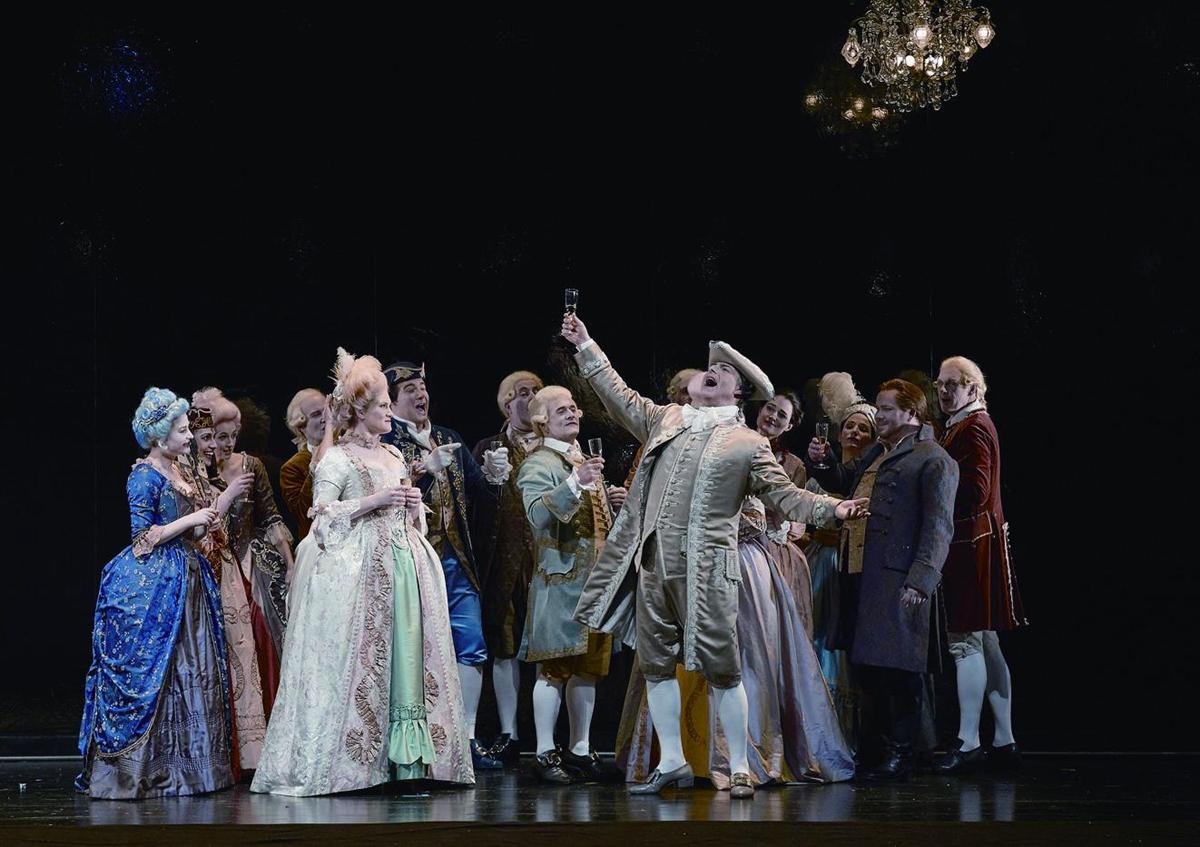
“To pivecko”
from Smetanas The Bartered Bride (1866)
Amidst an admittedly wine-heavy field—stagings of Offenbach and Romberg often depict beer, but the operas themselves refuse to take sides—we finally come to a composer unafraid of commitment. Smetana, the son of a brewer, has his villagers in The Bartered Bride unambiguously declaim “Beer is a gift from heaven” at the opening of Act II. Though the operas history had a rocky start—its early incarnation, with spoken dialogue, left audiences cold—Smetana revised his score to let the music do the talking, shaping its flow to the natural rhythms and pulses in the Czech language. When two characters begin arguing that either love or money is better than beer, the other villagers simply ignore them and keep drinking—a true hallmark of authenticity from a proudly beerdrinking culture.

